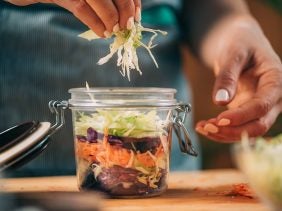What we love about fall vegetables – and some delish recipes
 ©NatashaBreen
©NatashaBreen
Fresh summer vegetables are great, but when the weather gets cooler, we certainly don’t have to worry about the delicious variety on our plates disappearing. Fall vegetables have lots to offer, so let’s go in depth into what’s fresh this time of year and how to prepare our favorites, like pumpkin and beetroot.
Which vegetables are fall vegetables?
Autumn is just around the corner – and with it, certain vegetables that help make the colder days a little heartier and cozier.
But which ones exactly are they? All varieties that can be harvested in the fall can survive different weather conditions than their summertime predecessors. Fall vegetables grow at low, cool temperatures, so they’re quite tolerant of the cold.
In autumn, cabbage lovers really get their money’s worth, because cruciferous vegetables, among others, really thrive. When temperatures drop, you’ll start to find plenty of pumpkin of all kinds, butternut squash, savoy cabbage, red and white cabbage, Chinese cabbage, cauliflower, and kale; as well as beetroot, parsnips, turnips, carrots, salsify, celery, fennel, spinach, corn, green beans, and various types of lettuce, including lamb’s lettuce, iceberg lettuce, and endive.
Check out your local farmer’s market for the colorful bunches that will brighten up your days, even as it gets darker. There are so many exciting recipes to try out, and even though it might be getting more uncomfortable outside, we’re keeping it warm inside with hearty meals, such as delicious soups and stews. But you can also conjure up lighter dishes with cauliflower, beetroot, fennel, and more.
And, as an extra bonus: the vegetables that are in our fall garden are both delicious and nutritious, and great sources of vitamins and minerals. In fact, seasonal vegetables have the best flavors anyway, the highest nutrient density, and grow under natural conditions. So, it’s always worth checking what’s actually in season before you go shopping.
List of fall vegetables: Favorite fall vegetable list
Cabbage
It’s not fall without cabbage! This family of veggie is versatile in the kitchen, because whether it’s cauliflower, kale, or brussels sprouts, each variety has its own appearance and flavors. Nevertheless, they all have something in common: no matter which, cabbage contains many vitamins and minerals, including B vitamins, vitamin C, folic acid, calcium, and iron.
Pumpkin
Nothing screams autumnal vibes more than pumpkin. They make great decorations, but they’re also an absolute hit in the kitchen. No wonder, because you can prepare pumpkin in many different ways. For example, you can roast them, grill them, puree them, or even pickle them. They also happen to be great options those who pay attention to a conscious diet. Pumpkin, like its relative butternut squash, is a super low-calorie fall vegetable, and has just 25 calories per 100 grams. And that’s including a good portion of vitamins, minerals, and satiating fiber.
Lamb’s lettuce
Spicy and nutty – lamb’s stands out as one of the more flavorful salad greens. It’s particularly great with cheese – be it goat cheese, feta, or mozzarella – for a taste explosion that is easy to prepare and enriches every fall day. And not only that, lamb’s lettuce is actually more nutritious than other leaf lettuces.
Spinach
We all know spinach is a real power food. It’s a good source of iron and also contains manganese, magnesium, calcium, and potassium as well as vitamins A, C, E, and K. That’s reason enough to include spinach in your fall meals in abundance, but it’s also versatile and can be used in many recipes, such as with fried eggs or in pasta or risotto.
Corn
The expression “small but mighty” fits corn perfectly. These small grains contain a good amount of potassium and magnesium as well as beta-carotene and folic acid. We love corn in salads or processed into polenta, i.e. corn semolina. But even a simple corn on the cob is perfect as a part of a cozy dinner at home. Nevertheless, you should keep in mind that, with 90 calories per 100 grams, corn is somewhat higher in calories compared to other vegetables.
Root vegetables: The aromatic tubers
As much choice as we have with fall crops, there’s nothing like root vegetables to satisfy the craving for something hearty. They’re aromatic, sometimes sweet, and are perfect for stews and creamy soups, as well as being a great side dish – for example, as roasted vegetables.
Beetroot
Bright red beets are absolute eye-catchers, but of course they have so much more to offer than looks. Beets are low in calories, but high in vitamins A, C, and B as well as betanin, potassium, magnesium, iron, and folic acid, making them valuable nutritional players. Beetroot can be eaten raw, for example, diced in a salad or cut up as a tartare. It also tastes delicious when cooked, for example as a side dish for meat and fish.
Carrots
Carrots are absolute classics, and for great reason. You should not underestimate this root vegetable, which holds its own in a wide range of cuisines and dishes – be it a Vietnamese curry or an Andalusian salad. Also, carrots are easily digestible with potassium, calcium, and iron, and they’re low in calories, so they’re one of our go-tos. By the way: carrots are orange due to carotenoids, which act as antioxidants that can, among other things, protect cells from damage.
Parsnips
Parsnips get a bit of hype these days, and their popularity is only increasing. Like carrots, they can be eaten both raw and cooked, and are perfect in a salad or added to mashed potatoes (or sweet potatoes!), for example. Their nutritional profile also scores highly, as they contain plenty of vitamin C and potassium. Plus, they’re very filling.
A quick look: fruit in autumn
Before we dive into some great recipes for fall vegetables, let’s venture into the world of fruit. After all, it is interesting to know which fruits are actually in season in the fall. These include apples, pears, quince, blackberries, plums, and grapes.
Our best recipes with fall vegetables
Asian cauliflower salad with fennel
Cauliflower, fennel and an Asian dressing – what a combo! This fresh combination is underlined by the roasted vegetables. This salad is more than just a side dish and can be quite suitable as a main course.
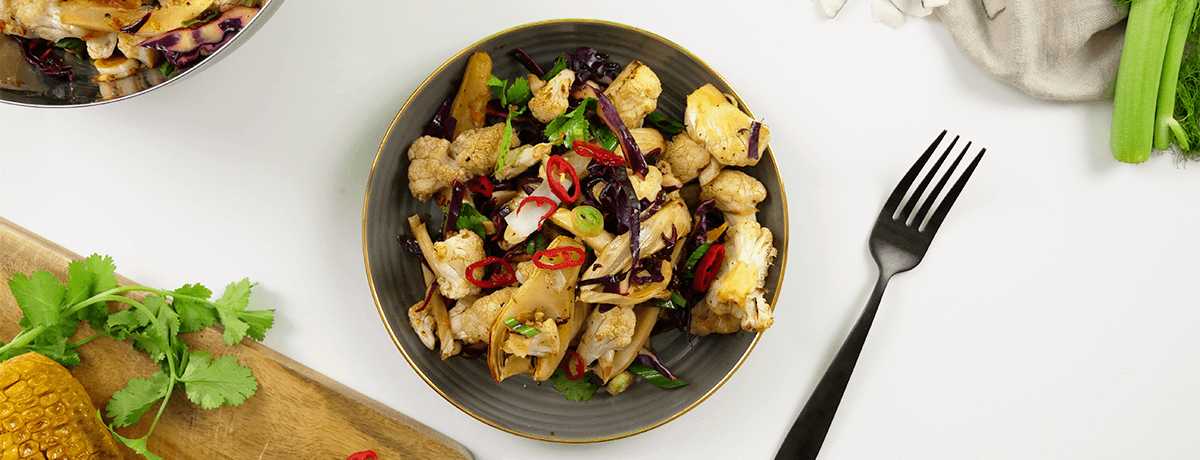
Sweet potato chicken bowl
When the rainy and cold weather rages outside, we like to cozy up with a bowl packed with fall vegetables. Sweet potatoes are in their finest season right now. With a balance of carbs, proteins, and healthy fats, this one is great for your body, and even more importantly, it keeps you feeling full. Maybe afterwards you can treat yourself to a little power nap.
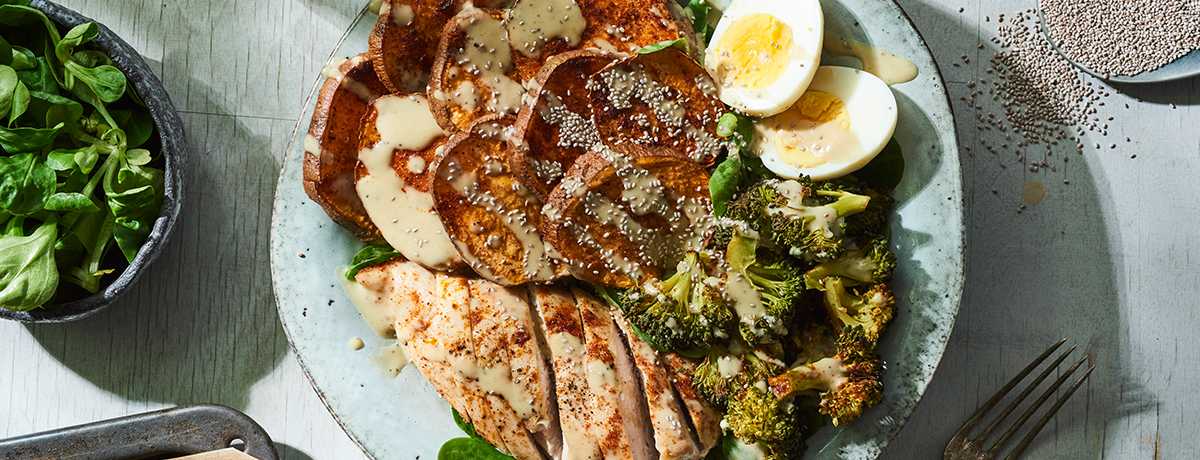
Beetroot soup
We can’t get enough of soups in autumn, especially when the temperatures are plummeting. This beet soup tastes hearty, but is also super light and vegan, too.
Our tip: Our Protein Flakes – boasting a fabulous protein content of 53 percent – give a little crunch and can simply be sprinkled over the soup.
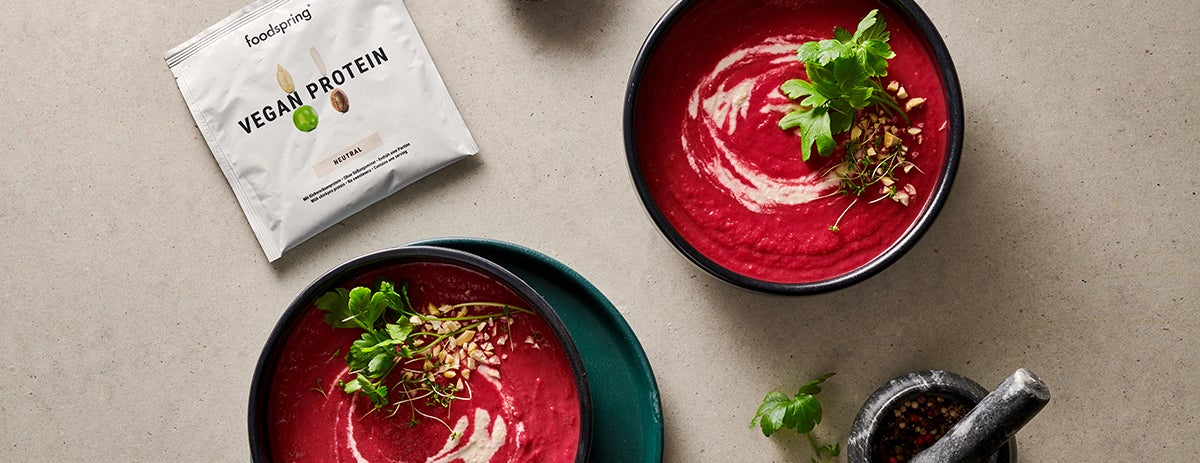
Protein pasta with kale pesto
Pesto is a classic recipe, and kale takes it to the next flavorful level. This dish is a creative way to use some kale and show this leafy green can be more than just a side dish.
Our tip: Ciao carbs! We recommend replacing conventional pasta with our Protein Pasta. It comes with 66 percent less carbohydrates, but four times more protein.

Protein Pumpkin Muffins
Pumpkin’s never boring in the kitchen, because it can be prepared in both savory and sweet dishes. Here, we’ve simply turned it into a delicious dessert or snack for a cozy TV evening – with a pleasantly nutty flavor.
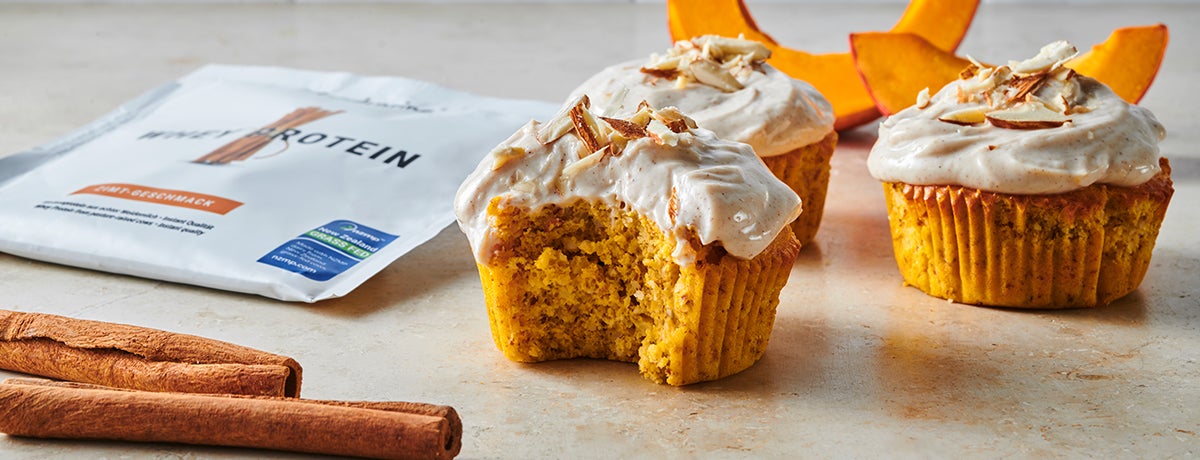
Summary
- In autumn, various types of cabbage, root vegetables, lamb’s lettuce, spinach, and green beans are in season.
- Fall vegetables are perfect for hearty, savory cooking because they are rich and flavorful.
- Whether soup, stew, pasta, or muffin – Fall vegetables can be prepared in many ways.
- Cabbage, pumpkin, beetroot, and other fall vegetables contain important vitamins and nutrients and are great additions to your menu when the cooler weather comes.
Sources for this article
We at foodspring use only high-quality sources, including peer-reviewed studies, to support the facts within our articles. Read our editorial policy to learn more about how we fact-check and keep our content accurate, reliable, and trustworthy.





























